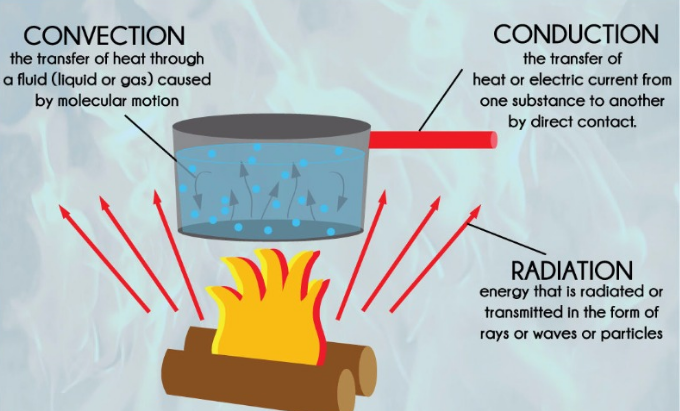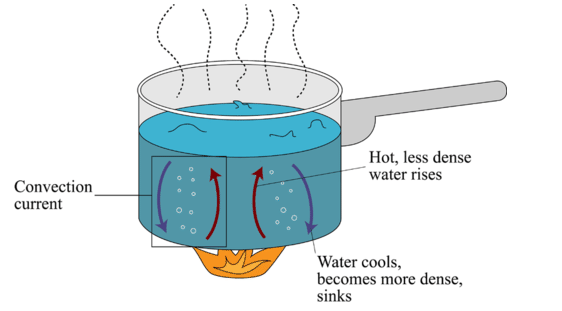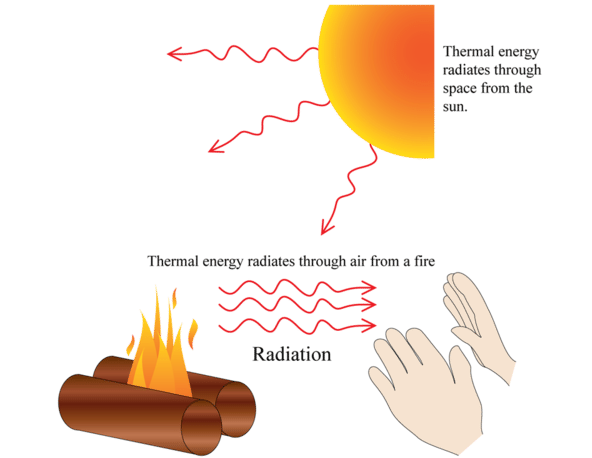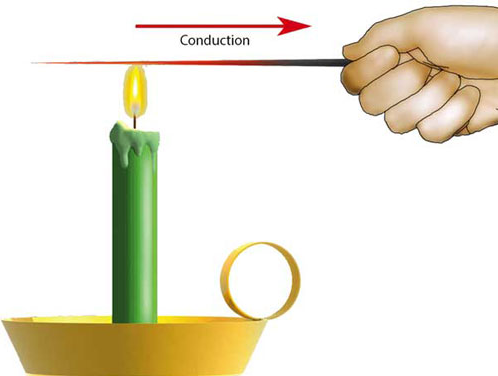Conduction, convection and radiation are the three major ways in which thermal energy can be transferred from one object/substance to another or from a system to its surroundings. Both conduction and convection requires matter to transfer heat. However, if there is a temperature difference between two systems heat will always find a way to transfer from the higher to a lower system.
Conduction occurs in solids while convection occurs in liquids. Radiation on the other hand does not require a medium, energy is transmitted through space.

What Is Conduction?
Conduction is a type of heat transfer that occurs in solid materials. It can be described as a process by which heat transfer occurs from molecule to molecule by direct conduct; the molecules themselves do not necessarily change position, but simply vibrate more or less quickly against each other.
In other words, conduction occurs when two objects at different temperature are in contact with each other and therefore, heat travels from the warmer object toward the colder object until they are both at the same temperature.
Examples of conduction
- A palm warming on a stove
- Heating a pan on stove
- Touching a hot cup of coffee
- Frying vegetables on a pan.
- Warming of your back muscles with a heating pad.
What You Need To Know About Conduction
- In conduction heat transfer occurs between objects that are in direct contact.
- Heat is transferred from a high temperature body/object to a low temperature object/body.
- It occurs only in solids.
- Conduction does not follow the laws of reflection.
- The speed of conduction is slower.
- The temperature difference or the difference in kinetic energy results in conduction.
- Continues until the temperature of the two objects is equal.
What Is Convection?
Convection occurs in liquids and gases and describes the movement of heat from one location to another facilitated by the movement of fluids/liquids. When heated, fluid expand and become less dense. The hot fluid rises and displaces the cold fluid located above it pushing down towards the heat source. The cold fluid will become heated and rise upwards creating a constant flow of fluid from an area of high heat to low heat.

Examples of convection
- Boiling water
- When warm water mixes with cold water.
- Movement of air in the atmosphere
- Land and sea breeze
- Chimney effect
- Melting of ice
What You Need To Know About Convection
- Convection is a form of heat transfer in which energy transition occurs within the fluid.
- Heat is transferred from a low density area to a high density area.
- It occurs in liquids and gas.
- Convection like conduction does not follow laws of reflection.
- The speed of convection is slow.
- The difference in density of the fluid results in convection.
- The cycle occurs while temperature difference exists.
What Is Radiation?
Radiation is the process of heat transfer in which heat is transferred without any medium or physical conduct in the form of electromagnetic waves. Radiation does not rely upon any contact between the heat source and the heated object. No mass is exchanged and no medium is required in the process of radiation.
Solar radiation warming the earth’s surface is an example of radiation. The radiation transfers from the sun through space and then strikes the earth. All objects emit radiation. Colder objects emit longer wavelength radiation while warmer objects emit shorter wavelength radiation.

Other examples of radiation
- Heat released from the filament of a light bulb.
- Heat from a stove burner
- Heat emitted by a radiator
- The light emitted by an incandescent lamp
- The transmission of electromagnetic waves through the microwave oven
What You Need To Know About Radiation
- In radiation heat is transferred without any medium or physical conduct in the form of electromagnetic waves.
- Energy is transferred through the rotational and vibrational movements of atoms and molecules.
- It occurs in all objects of solid, liquids and gas at a temperature above -273.15 oC (0K)or absolute temperature.
- Radiation does also not follow the laws of reflection.
- The speed of radiation is fast.
- Any object at a temperature greater than -273.15 oC (0k) can radiate.
- The transfer continues as long as there is energy to radiate.
Also Read: Difference Between Potential Energy And Kinetic Energy
Difference Between Conduction, Convection And Radiation
| BASIS OF COMPARISON | CONDUCTION | CONVECTION | RADIATION |
| Description | In conduction heat transfer occurs between objects that are in direct contact. | Convection is a form of heat transfer in which energy transition occurs within the fluid. | In radiation heat is transferred without any medium or physical conduct in the form of electromagnetic waves. |
| Heat Transfer | Heat is transferred from a high temperature body/object to a low temperature object/body. | Heat is transferred from a low density area to a high density area. | Energy is transferred through the rotational and vibrational movements of atoms and molecules. |
| Occurrence | It occurs only in solids. | It occurs in liquids and gas. | It occurs in all objects of solid, liquids and gas at a temperature above -273.15 oC (0K)or absolute temperature. |
| Laws of Reflection | Conduction does not follow the laws of reflection. | Convection like conduction does not follow laws of reflection. | Radiation does also not follow the laws of reflection. |
| Speed of Occurrence | The speed of conduction is slower. | The speed of convection is slow. | The speed of radiation is fast. |
| Factors Influencing | The temperature difference or the difference in kinetic energy results in conduction. | The difference in density of the fluid results in convection. | Any object at a temperature greater than -273.15 oC (0k) can radiate. |
| Effect of Temperature | Continues until the temperature of the two objects is equal. | The cycle occurs while temperature difference exists. | The transfer continues as long as there is energy to radiate. |
